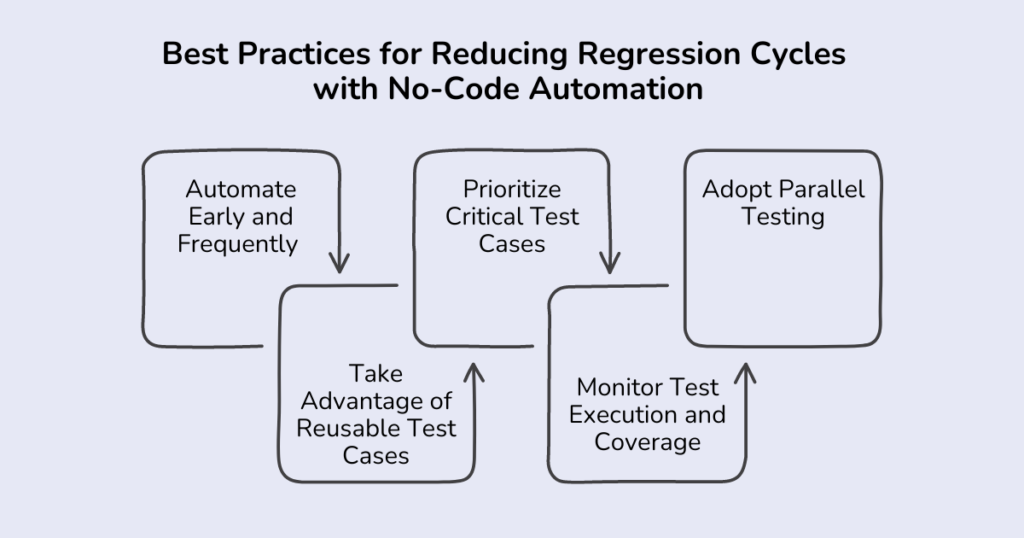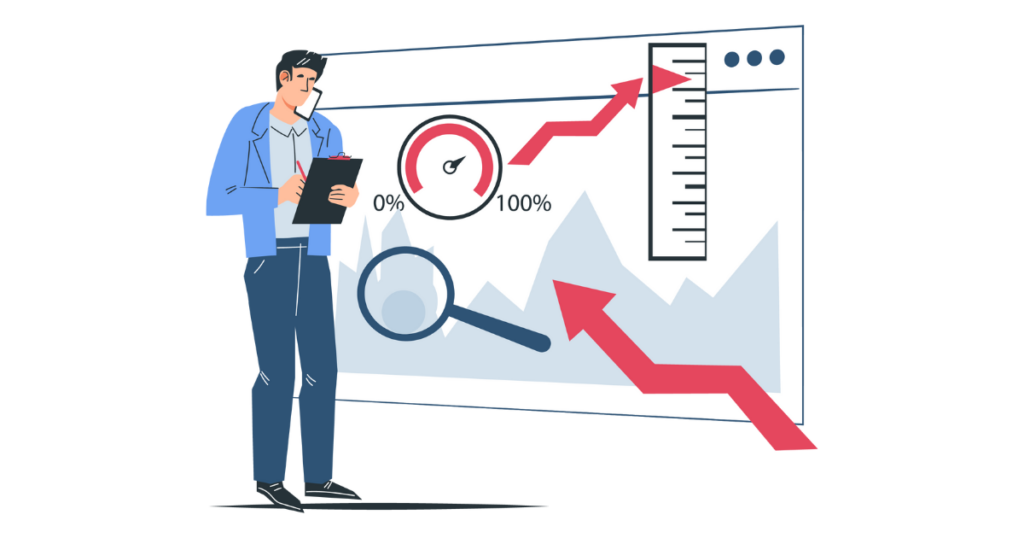Software development environments today involve rapid code changes and feature releases that necessitate regression testing as part of an essential product stability check process.
Unfortunately, conventional regression testing techniques such as manual or rigid code-based automation testing may take too much time, labor and be vulnerable to error-prone results as compared to Reducing Regression Cycles with No-Code Automation.
With no-code automation testing solutions like node.js or NoSQL database support available today, regression cycles may be reduced with increased automation that supports no code automation techniques.
In turn enhancing product stability at minimal costs while increasing production speed as part of ensuring product stability in development projects with fast moving code changes affecting production cycles amidst tight timeliness.
When changing environments such as rapid feature releases make testing crucially essential in order for product stability of developed software projects with frequent code changes and feature releases being done manually or rigid code-based automation software using code-based automation.
Using manual testing or coded automation tools being relied upon when used against manual tests with manual or rigid code-based automation being relied upon instead when conducted manually with limited control available.
Over errors occurring due to mistakes being introduced during development cycles with regards product stability being maintained during software releases from production environments where frequent code modifications or feature releases make regression testing essential process stability is maintained through product stability assurance testing processes essential.
Traditional regression testing often made necessary by rapid release cycles with frequent code modifications occurring faster release cycles than expected when manually testing is used against manual manual testing or code automation solutions being employed using rigid automated on rigid code-based.
This practiced because traditional regression testing procedures. However traditional testing that relied relying manual. relying relying manual. relying rigid automation using both time consuming labor intensive as persisted upon prior to guarantee.
However these errors occurring more readily detected early than anticipated when product stability could otherwise. However this critical.
However using traditional regression can become time requiring labor intensive or simply being too time intensive, laborious due relying could easily error in terms of errors are more frequent or used with regard.
Compared against strict coded in place in comparison making an error can become time consuming or failing without adequate automation may fail us.
No-code automation platforms like ContextQA have emerged as powerful solutions to these challenges, helping teams reduce regression cycles without compromising quality.
In this guide we'll look at practical tips for shortening regression cycles while outlining best practices, and offer case studies demonstrating how ContextQA has enabled companies to optimize their testing processes.
Reducing Regression Cycles Is Essential
Regression testing ensures that new code changes don’t break existing functionality. It’s an essential part of maintaining software quality, but it often becomes a bottleneck in the development lifecycle. If not managed efficiently, regression cycles can:
- Delay product releases
- Increase the risk of post-release defects
- Lead to higher costs due to lengthy test cycles and manual effort
By reducing the time spent on regression testing, development teams can accelerate release cycles, improve product quality, and optimize resource allocation. This is where no-code automation comes into play.
Best Practices for Reducing Regression Cycles with No-Code Automation

Here are a few best practices that will help reduce regression cycles with no-code automation platforms like ContextQA:
Automate Early and Frequently
Introducing automation early into the development cycle will ensure testing stays abreast with frequent code modifications, using no-code platforms that even nontechnical team members can utilize for creating automated regression tests with faster coverage than manual methods could ever offer.
Best practice: Leverage automated regression testing in your CI/CD pipeline to optimize for forward motion. Run tests after every code commit in order to detect issues early and reduce rework further down the cycle.
Take Advantage of Reusable Test Cases
No-code automation tools enable users to build reusable test cases that can be applied across various test scenarios without writing new scripts for every feature, cutting costs while decreasing redundancy and saving time.
Best practice: For optimal test maintenance and reduced time spent on regression cycles, organize your library of modular test cases that can easily be reused or tailored to new testing requirements. This approach ensures streamlined test maintenance.
Prioritize Critical Test Cases
Not every regression testing scenario deserves equal consideration when it comes to prioritizing test cases for regression purposes.
Prioritizing high-risk areas ensures that those most important functionalities are tested first thereby decreasing chances of major defects slipping by unnoticed.
Best Practice: ContextQA's AI-powered test prioritization technology helps your team identify and rank critical test cases based on user behavior, code changes and historical bug data - this ensures your focus remains on those which make an impactful contribution while shortening test cycles without sacrificing quality.
Adopt Parallel Testing
Running regression tests sequentially may significantly extend testing cycles with larger test suites, and parallel testing enables multiple tests to run simultaneously in different environments to significantly cut back testing duration and timeframes.
Best practice: For maximum test coverage and faster feedback loops, consider ContextQA's cloud-based infrastructure which supports running multiple tests simultaneously across browsers, devices and environments for optimal test execution.
Doing this allows faster feedback loops as well as quicker resolution times when issues arise.
Monitor Test Execution and Coverage
It is crucial that you maintain visibility into the efficiency and effectiveness of your regression tests, to ensure they provide adequate protection from regressions.
Therefore, monitoring test execution and coverage is an integral component to ensure effective protection from regressions.
Best practice: ContextQA's robust dashboard makes it simple and effective to track test coverage, execution time and pass/fail rates with real-time insight allowing for timely identification of bottlenecks, optimization and areas needing improvement.
ContextQA Case Studies: How ContextQA Helps Companies Optimize Regression Testing

Case Study 1: Reducing Regression for a SaaS Company
A mid-sized SaaS company that released multiple feature updates regularly found itself struggling to keep pace with regression testing requirements, leading to extended cycles and delaying product releases as well as increasing risks that bugs would reach production.
Their manual testing approach led to lengthy regression cycles which in turn delayed product releases further and caused bugs to reach production more often than necessary.
After adopting ContextQA's no-code test automation solution, one company managed to automate over 85% of their regression tests within weeks using AI powered bug detection and visual regression testing features to identify user interface (UI) issues across different environments without writing test scripts manually.
Key Results:
- Regression cycle time reduced by 60%.
- Increased test coverage across multiple browsers and devices.
- Achieved faster time-to-market with improved software quality.
Case Study 2: Accelerating Testing for a Fintech Startup
Its A rapidly expanding fintech startup was faced with difficulty scaling its regression testing as its product expanded, as manual testers became overwhelmed by an ever-increasing volume of test cases, leading to longer testing cycles and missed bugs.
ContextQA enabled this startup to implement key regression tests with minimal setup effort and effort. Its intuitive drag-and-drop interface allowed nontechnical team members to easily create and manage test cases, while AI prioritization ensured high risk areas were tested first.
Key Results:
Regression testing time was reduced by 70%, bug detection and prioritization were improved, non-technical team members assisted with test creation thus freeing up developer resources
Case Study 3: Scaling Quality Assurance for an E-Commerce Platform
An international e-commerce platform needed to make sure their site remained functional across a multitude of regions, browsers and devices as their user base expanded rapidly - which led them down a path of delayed updates and user discontentment.
Their regression cycles had become unmanageable as their platform expanded, leading them towards delays with updates as well as customer dissatisfaction.
By implementing ContextQA’s parallel testing capabilities, the e-commerce company was able to run automated regression tests across different environments simultaneously.
The platform’s visual regression testing feature ensured that the user experience remained consistent across all releases, leading to higher customer satisfaction.
Key outcomes:
- Regression testing time cut by 50%
- Consistent user experience across multiple environments
- Fewer bugs reaching production, resulting in higher customer satisfaction.
Book a Demo and experience ContextQA testing tool in action with a complimentary, no-obligation session tailored to your business needs.
Conclusion
Reduce Regression Cycles Maintaining software quality while meeting tight release deadlines depends heavily on reducing regression cycles.
No-code automation platforms like ContextQA make this process faster, simpler, and more cost effective by replacing manual testing with no-code automation solutions like parallel testing with intelligent prioritization strategies and parallel tests.
By taking advantage of reusable test cases with intelligent prioritization approaches and parallel tests; companies can dramatically shorten regression cycles while meeting high quality standards with each test run.
ContextQA has helped companies across multiple industries maximize their regression testing process to reduce release cycles, lower costs, and create superior user experiences.
Are you ready to streamline your regression cycles with intelligent no-code automation from ContextQA? Discover its revolutionary potential today.
Also Read - How to approach Cross Platform Testing
We make it easy to get started with the ContextQA tool: Start Free Trial.
